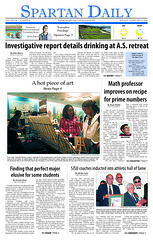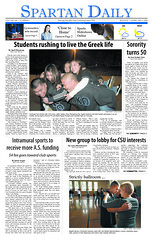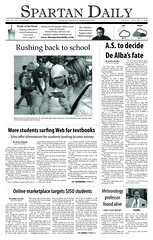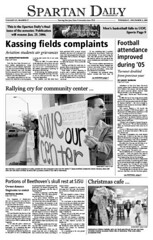Within the March 2005 edition of News Photographer magazine can be found an article by
Jenni Kolsky Goldman, photojournalism professor at Cal Poly Pomona. The article, entitled "The First Job Out of College: What Are Editors Really Looking For in a Recent Grad?" laid out what current photojournalism students must strive for in order to better their chances of being employed as a photojournalist upon graduation.
Much of the article was information that students should already know. Internships are a must (at least one, not too many). Many students need to improve their writing skills, especially when dealing with captions. A good portfolio is like a good first impression and should include sports, news, and a picture story. Avoid cliche photos in your portfolio. And photojournalism schools are helpful, but there are only a handful of "good" ones (SJSU being mentioned among a few others).
There was one part in particular that caught my attention. J. Bruce Baumann, executive editor of
The Courier & Press of Evansville, IN was quoted as saying
We are looking for people who don't have tunnel vision, by that I mean people who think about more things than photojournalism...and people who have interests besides newspapers. When somebody tells me that all they do is photography and all they want is to work on newspapers, I don't think they have a life. I am looking for someone who has a life.
This struck me for two reasons. Initially I took it from an educational context. I related it to the instruction at Brooks, which focuses solely on photography at the expense of other subjects or even current events. Taken from a broader standpoint, it seemed as though Mr. Baumann was simply stating that students should not let photojournalism take up their entire life. Students should have other interests, hobbies, etc. Is this to mean that Mr. Baumann discourages students who are completely dedicated to their craft? Aren't we always taught that the best results come to those who put in the most effort? Is this view shared by many other professionals? Shouldn't a photojournalist carry a camera at all times?
While I agree that one cannot be totally consumed with photojournalism at all times, it seems that the role of photojournalist is not something that ends when one clocks out at night. Using the tragic landslide at La Conchita as an example, if a photojournalist happened to be vacationing in nearby Montecito or Santa Barbara, I would assume that is it likely that the photojournalist would rush over to La Conchita and begin recording events there. By assuming the role of photojournalist, one must be prepared to cover the unexpected. It does become your life.










